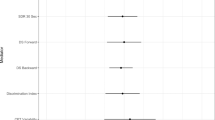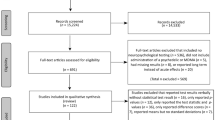Abstract
3,4-Methylenedioxymethamphetamine (MDMA, ‘Ecstasy’) and cannabis are two of the most commonly used illicit drugs in the western world, and are often used in combination. Very little research has examined their effect on cognitive function or behavior when combined. The present study used a double Y-maze task to examine the acute effect of MDMA and Δ9-tetrahydrocannabinol (THC, the principal psychoactive ingredient of cannabis) on mnemonic function in rats, at a range of doses representative of common human use. Experiment 1 (low doses) examined the effect of 0.25 mg/kg THC and 1.25 mg/kg MDMA alone and together. At these doses MDMA or THC given alone had no effect on working memory, but the co-administered drugs significantly disrupted working memory. Experiment 2 (medium doses) examined the effect of 0.5 mg/kg THC and 2.5 mg/kg MDMA given alone or together. At these doses THC, but not MDMA, impaired working memory. Although MDMA alone had no effect, it exacerbated the impairment due to THC when the drugs were co-administered. Experiment 3 (high doses) examined the effects of 1 mg/kg THC and 5 mg/kg MDMA alone and together. Both drugs significantly impaired memory when given alone, although the impairment due to MDMA was less than that caused by THC. When co-administered at these doses, the drugs caused a major disruption of behavior and this precluded ascribing a mnemonic cause to poor performance on the double Y-maze task. Taken together, these experiments demonstrate a synergistic disruption of working memory by acute co-administration of THC and MDMA.
Similar content being viewed by others
Log in or create a free account to read this content
Gain free access to this article, as well as selected content from this journal and more on nature.com
or
References
Acquas E, Marrocu P, Pisanu A, Cadoni C, Zernig G, Saria A et al (2001a). Intravenous administration of ecstasy (3,4-methylenedioxymethamphetamine) enhances cortical and striatal acetylcholine release in vivo. Eur J Pharmacol 418: 207–211.
Acquas E, Pisanu A, Marrocu P, Goldberg SR, di Chiara G (2001b). Δ9-tetrahydrocannabinol enhances cortical and hippocampal acetylcholine release in vivo: a microdialysis study. Eur J Pharmacol 419: 155–161.
Ameri A (1999). The effects of cannabinoids on the brain. Progr Neurobiol 58: 315–348.
Barrionuevo M, Aguirre N, Del Rio J, Lasheras B (2000). Serotonergic deficits and impaired passive-avoidance learning in rats by MDEA: a comparison with MDMA. Pharmacol Biochem Behav 65: 233–240.
Bergson C, Levenson R, Goldman-Rakic PS, Lidow MS (2003). Dopamine receptor-interacting proteins: the Ca2+ connection in dopamine signaling. Trends Pharmacol Sci 24: 486–492.
Bolla KI, McCann UD, Ricaurte GA (1998). Memory impairment in abstinent MDMA (‘Ecstasy’) users. Neurology 51: 1532–1537.
Boot BP, McGregor IS, Hall W (2000). MDMA (Ecstasy) neurotoxicity: assessing and communicating the risks. Lancet 355: 1818–1821.
Braida D, Pozzi M, Cavallini R, Sala M (2002). 3,4-Methylenedioxymethamphetamine (Ecstasy) impairs eight-arm radial maze performance and arm entry pattern in rats. Behav Neurosci 116: 298–305.
Chen J, Paredes W, Lowinson JH, Gardner EL (1991). Strain-specific facilitation of dopamine efflux by Δ9-tetrahydrocannabinol in the nucleus accumbens of rat: an in vivo microdialysis study. Neurosci Lett 129: 175–179.
Christophersen AS (2000). Amphetamine designer drugs—an overview and epidemiology. Toxicol Lett 112: 127–131.
Climko RP, Roehrich H, Sweeney DR, Al-Razi J (1986). Ecstasy: a review of MDMA and MDA. Int J Psychiatry Med 16: 359–372.
Cole JC, Sumnall HR (2003). The pre-clinical behavioural pharmacology of 3,4-methylenedioxymethamphetamine (MDMA). Neurosci Biobehav Rev 27: 199–217.
Croft RJ, Mackay AJ, Mills ATD, Gruzelier JGH (2001). The relative contributions of ecstasy and cannabis to cognitive impairment. Psychopharmacology 153: 373–379.
Daumann J, Schnitker R, Weidemann J, Schnell K, Thron A, Gouzoulis-Mayfrank E (2003). Neural correlates of working memory in pure and polyvalent ecstasy (MDMA) users. NeuroReport 14: 1983–1987.
Diana M, Melis M, Gessa GL (1998). Increase in meso-prefrontal dopaminergic activity after stimulation of CB1 receptors by cannabinoids. Eur J Neurosci 10: 2825–2830.
Downing J (1986). The psychological and physiological effects of MDMA on normal volunteers. J Psychoactive Drugs 18: 335–340.
Egashira N, Mishima K, Katsurabayashi S, Yoshitake T, Matsumoto Y, Ishida J et al (2002). Involvement of 5-hydroxytryptamine neuronal system in Δ9-tetrahydrocannabinol-induced impairment of spatial memory. Eur J Pharmacol 445: 221–229.
Essman EJ (1984). Marijuana intoxication in rats: interruption of recent memory and effect on brain concentration of delta-9-tetrahydrocannabinol. Psychol Bull 55: 563–567.
Fischer HS, Zernig G, Schatz DS, Humpel C, Saria A (2000). MMA (‘ecstasy’) enhances basal acetylcholine release in brain slices of the rat striatum. Eur J Neurosci 12: 1385–1390.
Frederick DL, Paule MG (1997). Effects of MDMA on complex brain function in laboratory animals. Neurosci Biobehav Rev 21: 67–78.
Gaoni Y, Mechoulam R (1964). Isolation, structure, and partial synthesis of an active constituent of hashish. J Am Chem Soc 86: 1646–1647.
Gouzoulis-Mayfrank E, Daumann J, Tuchtenhagen F, Pelz S, Becker S, Kunert H-J et al (2000). Impaired cognitive performance in drug free users of recreational ecstasy (MDMA). J Neurol Neurosurg Psychiatry 68: 719–725.
Herkenham M, Lynn AB, Little M, Johnson R, Melvin L, de Costa BR et al (1990). Cannabinoid receptor localisation in brain. Proc Natl Acad Sci USA 87: 1932–1936.
Hermann H, Marsicano G, Lutz B (2002). Coexpression of the cannabinoid receptor type 1 with dopamine and serotonin receptors in distinct neuronal subpopulations of the adult mouse forebrain. Neuroscience 109: 451–460.
Heyser CJ, Hampson RE, Deadwyler SA (1993). Effects of delta-9-tetrahydrocannabinol on delayed match to sample performance in rats: alterations in short-term memory associated with changes in task specific firing of hippocampal cells. J Pharmacol Exp Therap 264: 294–307.
Jacobsen LK, Mencl WE, Pugh KR, Skudlarski P, Krystal JH (2004). Preliminary evidence of hippocampal dysfunction in adolescent MDMA (‘ecstasy’) users: possible relationship to neurotoxic effects. Psychopharmacology 173: 383–390.
Jentsch JD, Andrusiak E, Tran A, Bowers Jr MB, Roth RH (1997). Δ9-Tetrahydrocannabinol increases prefronta lcortical catecholaminergic utilization and impairs spatial working memory in the rat: blockade of dopaminergic effects with HA 966. Neuropsychopharmacology 16: 426–432.
Lichtman AH, Martin BR (1996). Δ9-Tetrahydrocannabinol impairs spatial memory through a cannabinoid receptor mechanism. Psychopharmacology 126: 125–131.
Mallet PE, Beninger RJ (1993). The double Y-maze as a tool for assessing memory in rats. Neurosci Protocols 93: 01–11.
Mallet PE, Beninger RJ (1996). The endogenous cannabinoid receptor agonist anandamide impairs memory in rats. Behav Pharmacol 7: 276–284.
Mallet PE, Beninger RJ (1998). The cannabinoid CB1 receptor antagonist SR141716A attenuates the memory impairment produced by Δ9-tetrahydrocannabinol or anandamide. Psychopharmacology 140: 11–19.
Mason KI, Mallet PE, Jhamandas K, Boegman RJ, Beninger RJ (1999). Nucleus basalis injections of N-methyl-D-aspartate enhance memory of rats in the double Y-maze. Brain Res Bull 48: 65–71.
May R, Hunter M, Gabriel R (1993). NPFact 1.0. http://home.utah-inter.net/rmay/npstat.html.
Molina-Holgado F, Gonzalez MI, Leret ML (1995). Effect of Δ9-tetrahydrocannabinol on short-term memory in the rat. Physiol Behav 57: 177–179.
Nakamura EM, da Silva EA, Concilio GV, Wilkinson DA, Masur J (1991). Reversible effects of acute and long-term administration of Δ-9-tetrahydrocannabinol (THC) on memory in the rat. Drug Alcohol Depend 28: 167–175.
Nava F, Carta G, Colombo G, Gessa GL (2001). Effects of chronic Δ9-tetrahydrocannabinol treatment on hippocampal extracellular acetylcholine concentration and alternation performance in the T-maze. Neuropharmacology 41: 392–399.
Parrott AC, Lasky J (1998). Ecstasy (MDMA) effects upon mood and cognition: before, during and after a Saturday night dance. Psychopharmacology 139: 261–268.
Parrott AC, Lees A, Garnham NJ, Jones M, Wesnes K (1998). Cognitive performance in recreational users of MDMA or ‘ecstasy’: evidence for memory deficits. J Psychopharmacol 12: 79–83.
Parrott AC, Sisk E, Turner JJD (2000). Psychobiological problems in heavy ‘ecstasy’ (MDMA) polydrug users. Drug Alcohol Depend 60: 105–110.
Pistis M, Ferraro L, Pira L, Flore G, Tanganelli S, Gessa GL et al (2002). Δ9-Tetrahydrocannabinol decreases extracellular GABA and increases extracellular glutamate and dopamine levels in the rat prefrontal cortex: an in vivo microdialysis study. Brain Res 948: 155–158.
Reneman L, Booij J, Schmand B, van den Brink W, Gunning B (2000). Memory disturbances in ‘Ecstasy’ users are correlated with an altered brain serotonin neurotransmission. Psychopharmacology 148: 322–324.
Ricaurte GA, Markowska AL, Wenk GL, Hatzidimitriou G, Wlos J, Olton DS (1993). 3,4-Methylenedioxymethamphetamine, serotonin and memory. J Pharmacol Exp Therap 266: 1097–1105.
Roiser JP, Sahakian BJ (2003). Relationship between ecstasy use and depression: a study controlling for poly-drug use. Psychopharmacology 173: 411–417.
Schifano F, Oyefeso A, Corkery J, Cobain K, Jambert-Gray R, Martinotti G et al (2003). Death rates from ecstasy (MDMA, MDA) and polydrug use in England and Wales 1996–2002. Hum Psychopharmacol Clin Exp 18: 519–524.
Shankaran M, Gudelsky GA (1998). Effect of 3,4-methylenedioxymethamphetamine (MDMA) on hippocampal dopamine and serotonin. Pharmacol Biochem Behav 61: 361–366.
Smart RG, Ogborne AC (2000). Drug use and drinking among students in 36 countries. Addict Behav 25: 455–460.
Smith CG, Beninger RJ, Mallet PE, Jhamandas K, Boegman RJ (1994). Basal forebrain injections of the benzodiazepine partial inverse agonist FG 7142 enhance memory of rats in the double Y-maze. Brain Res 666: 61–67.
Tancer M, Johanson C-E (2003). Reinforcing, subjective, and physiological effects of MDMA in humans: a comparison with d-amphetamine and mCPP. Drug Alcohol Depend 72: 33–44.
Topp L, Hando J, Dillon P, Roche A, Solowij N (1999). Ecstasy use in Australia: patterns of use and associated harm. Drug Alcohol Depend 55: 105–115.
Turner C, Russell A, Brown W (2003). Prevalence of illicit drug use in young Australian women, patterns of use and associated risk factors. Addiction 98: 1419–1426.
Varvel SA, Hamm RJ, Martin BR, Lichtman AH (2001). Differential effects of Δ9 THC on spatial reference and working memory in mice. Psychopharmacology 157: 142–150.
Verheyden SL, Henry JA, Curran HV (2003). Acute, sub-acute and long-term subjective consequences of ‘ecstasy’ (MDMA) consumption in 430 regular users. Hum Psychopharmacol Clin Exp 18: 507–517.
Vollenweider FX, Gamma A, Liechti M, Huber T (1998). Psychological and cardiovascular effects and short-term sequelae of MDMA (‘Ecstasy’) in MDMA-naive healthy volunteers. Neuropsychopharmacology 19: 241–251.
White SR, Obradovic KM, Imel KM, Wheaton MJ (1996). The effects of methylenedioxymethamphetamine (MDMA, ‘Ecstasy’) on monoaminergic neurotransmission in the central nervous system. Progr Neurobiol 49: 455–479.
Winstock AR, Griffiths P, Stewart D (2001). Drugs and the dance music scene: a survey of current drug use patterns among a sample of dance music enthusiasts in the UK. Drug Alcohol Depend 64: 9–17.
Acknowledgements
This study was supported by an Australian Research Council Grant to ISM and PEM and an NH&MRC grant to ISM. JMY's PhD studies were supported by an Australian Postgraduate Award.
Author information
Authors and Affiliations
Corresponding author
Rights and permissions
About this article
Cite this article
Young, J., McGregor, I. & Mallet, P. Co-administration of THC and MDMA (‘Ecstasy’) Synergistically Disrupts Memory in Rats. Neuropsychopharmacol 30, 1475–1482 (2005). https://doi.org/10.1038/sj.npp.1300692
Received:
Accepted:
Published:
Issue date:
DOI: https://doi.org/10.1038/sj.npp.1300692
Keywords
This article is cited by
-
Peripheral endocannabinoid concentrations are not associated with verbal memory impairment during MDMA intoxication
Psychopharmacology (2018)
-
Toxicity of amphetamines: an update
Archives of Toxicology (2012)
-
MDMA attenuates THC withdrawal syndrome in mice
Psychopharmacology (2007)



